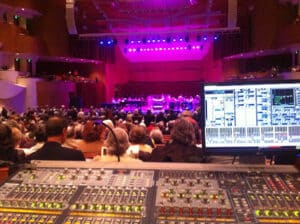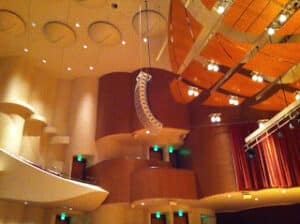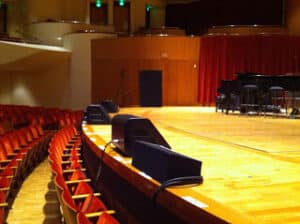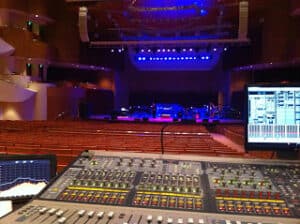As an Amazon Associate DcSoundOp earns from qualifying purchases.

The Tenors, like many touring groups, carry a certain amount of gear with them to all engagements, giving them a baseline of necessary quality gear (microphones, monitor mixer, IEM units etc.) to perform any sized show comfortably. These guys really have great ears and rely on some high quality equipment to both monitor and translate their performance to the audience accurately. Their fly-in tour kit consists of the following.Over this past Thanksgiving weekend, the popular touring group The Canadian Tenors came through Baltimore on a short run of a special holiday themed show featuring the Baltimore Symphony Orchestra along with the Tenors usual sidemen. I was excited to get the call to handle front of house duties for the weekend, with Mark Bradley (Clair Bros. / Phish) handling the many monitoring needs on stage with the larger (then usual) group. We had three days for the whole production, load-in took place early Friday morning, with setup – soundcheck and our first show Friday evening. We had a show on Saturday night, and another afternoon show on Sunday. Due to the large group and scheduling conflicts on the holiday weekend, the rehearsal and soundcheck time was limited to only a few hours on Friday afternoon, which made for a hectic and interesting day. Let’s take a look at the system and see what went into pulling this show together.
- (2) Sennheiser 3732-II RF microphone receivers w/ combiner and paddle set.
- (4) Sennheiser SKM 5200-II RF microphone transmitters
- (4) Neumann KMS 104 RF microphone capsules
- (5) Sennheiser RF IEM receiver belt packs (1 spare)
- (4) Sennheiser SR2050 RF IEM transmitters w/ combiner & dome antenna
- (2) Lexicon MX300 – Dual mono reverb units (1ch for each lead singers IEM mix)
- (1) APB ProRack-Monitor (M1016) Monitor Console.
- (2) Neumann KM184 pencil condenser microphones for piano.

With Mark handling the monitor duties for this show, I cannot speak to exactly what and how he had everything on the desk routed, but I’ll give a brief overview of what was required for this event. Having the orchestra on-board wasn’t too much of a problem for monitoring, as they were working with a capable conductor and did not require individual monitoring for each musician in the orchestra. Here is the list of mixes that were required for the weekend.On this specific job, we had a larger group of performers and a great crew handling all of the monitor needs through a Yamaha PM5D-RH, so the APB mixer and the two lexicon reverb units were not put to use. That gear gets used on smaller gigs where there may not be adequate monitoring on hand, therefore giving the guys a mix that they are comfortable with right out of the box.
1-Downstage Right [mono wedge] (Mix1)
2-Downstage Center Right [mono wedge] (Mix2)
3-Downstage Center Left [mono wedge] (Mix3)
4-Downstage Left [mono wedge] (Mix4)
5-Stereo IEM Mix (Remi) [w/ discreet reverb]
6-Stereo IEM Mix (Fraser) [w/ discreet reverb]
7-Stereo IEM Mix (Victor) [w/ discreet reverb]
8-Stereo IEM Mix (Clifton) [w/ discreet reverb]
9-Mono IEM Mix (Pianist)
10-Mono IEM Mix (Drummer)
11-Mono IEM Mix (Electric Bass)
12-Mono IEM Mix (Electric Guitar)
13-Mono IEM Mix (Orchestra Conductor)
14-Mono HotSpot/Com Mix (Orchestra Conductor)
**There were plans to have additional fill speakers located throughout the orchestra if we needed them, but after some listening and discussion, the orchestra decided they did not require any additional monitoring**

Unfortunately, as it tends to happen in this business, schedules were tough to coordinate on this job due to the large orchestra, and our rehearsal time in the hall was down to the same few hours in the afternoon on Friday, which would typically have been our sound check time. What this meant to me was that I simply could not spend time asking to hear individual instruments, I would have to catch things on the fly as they happen and build around what they give me. Allowing the musicians as much time to rehearse the way they needed to in the hall was of paramount importance, being flexible in our workflow made that possible and at the end of the allotted time, we were all feeling ready to put on a solid show for that night’s audience.Load-in went smoothly, as I was there to handle the needs of The Tenors and the in-house union crew were handling all of the system deployment duties. The crew at the Joseph Meyerhoff Symphony Hall in Baltimore City are an absolute top-notch group of professionals. Showing up prior to the call time, seeing the crew already outside, all excited to get in and get to work, all friendly and professional to chat with, was a great start to the first day. We got inside the hall, they introduced me to the console at the FOH position, and we all basically put our heads down and got the work done. Two hours or so later, we were pinning out the last of the inputs and starting to line check the stage.

Returning from a brief dinner, I stuck on some walk-in music and sat down behind the console to get ready for the actual performance. Working on the house supplied Avid Venue Profile, I had all the tools I needed at my disposal for shaping the individual sound. During the afternoon rehearsal, I was able to hear all of the different sources coming from the stage, but due to the arrangements of the various songs that were rehearsed, I had not yet heard all of the instruments in-situ with the rest of their ensembles. I was pleased with the results of my work earlier in the day, but I knew that once we got into the heat of the actual show, I would need to have a few more tools in place to hold it all together.
In this type of a show, I am a big fan of using mix buses to organize and process sources in logical groups. I know that there are many folks who will instead use a DCA (or VCA) to control (groups) of inputs, and not actually route any audio through mix buses for processing. The DCA/VCA method is absolutely workable and is something I will use if I feel as though I am able to get the sounds I need utilizing only the individual channel processing. On this show however, I had distinct needs to actually process my various groups at the (group) level. Let’s look now at my FOH layout, how I built my mix, and what tools were used to pull everything together.

Inputs:
- 1-Kick In
- 2-Kick Out
- 3-Snare (Main)
- 4-Snare (Aux Snare)
- 5-Hats
- 6-Rack 1
- 7-Rack 2
- 8-Floor 1
- 9-Floor 2
- 10-Overhead Left
- 11-Overhead Right
- 12-Aux Perc. Oh
- 13-Bass Guitar Mic
- 14-Bass Guitar DI
- 15-Electric Guitar
- 16-Acoustic Guitar 1
- 17-Acoustic Guitar 2
- 18-Piano Low
- 19-Piano Mid
- 20-Piano High
- (21-29)- Keyboards
- 30-Vocal 1
- 31-Vocal 2
- 32-Vocal 3
- 33-Vocal 4
- (34-48)- Orchestra (Principal players w/ DPA4099 clip mics, Remaining Sections w/ Stereo Pairs of Shure KSM32 condenser microphones).
Looking simply at my input list above, you can already begin to see that I have grouped instruments in a reasonably logical way. With a digital console like the Avid Profile that I was using on this show, physical input patch order is less critical, as I can soft patch any physical input to any channel on the console easily. Being able to move things freely around the console can be a great help in creating your workflow, but I find it is often an advantage to stick to a patch scheme that will make sense to everyone on the show crew, not just one that suits me that day. When you’re dealing with a moderate to high channel count show, with a monitor engineer and stage crew keeping track of your patching on-stage, it can become cumbersome in a hurry if you have to constantly do the conversion in your head between your channel placement on the desk, the physical input on the console or stage-box and any sub snakes that you might have deployed. Sticking to an input list that is logical and based on a typical (festival patch) scheme will keep you on the same mental page as your monitor engineer & stage crew counterparts.
The next logical step is to assign our mixes… so looking at how I have grouped my inputs, what mix groups would make sense? Remember, keeping things logical and simple is the key here, we’re not looking to discover new uncharted sonic territories, just to make some basic grouping decisions that will allow us to solve a few basic problems.
Groups:
1-Drums
2-Bass
3-Guitars
4-Keyboards
5-Piano
6-Vocals (1)
7-Vocals (2)
8-Orchestra
***It’s worth noting here that we were running an Aux fed path to the subwoofers, allowing all of the sub content to be processed on that output. Aux fed subs often get a lot of attention for allowing more control over what content goes to the sub-woofers, but they also allow more flexibility in how you are able to process your group outputs, more on this in a moment.
With this show, my primary concern is to make sure the vocals are intelligible and on top of the mix at all times. With a full backing band, an orchestra, and a range of songs that run from whisper quite to full on in your face rock-n-roll, creating a mix that keeps the vocal relationship consistent while pushing the energy in the right direction can be a bit of a challenge. Perhaps you noticed above, that while I have a mix bus for each logical instrument group, I have two groups setup for handling the vocals, this is a key to how I maintained consistency throughout the show. So, let’s get into the mix…
 The way I work when building a mix may differ some from what you’re used to, this seems to be the case to me at least, when I see others conducting a sound check and building their mixes. The number one most common thing I see others do when building a mix, is that they start their sound-check with the first input on the console, which is typically the kick drum mic. Now, I don’t want to suggest that a good mix cannot be built this way, but it sure can lead you down a tricky road if you’re not paying close attention to what you are doing. When conducting a simple line-check, it is logical to start at input number one and move through the inputs sequentially, but when it comes time to build an actual mix during a sound-check, I work by identifying my most important inputs, working on them first and building a mix around them, allowing them to stay on-top and in-front where they need to be.
The way I work when building a mix may differ some from what you’re used to, this seems to be the case to me at least, when I see others conducting a sound check and building their mixes. The number one most common thing I see others do when building a mix, is that they start their sound-check with the first input on the console, which is typically the kick drum mic. Now, I don’t want to suggest that a good mix cannot be built this way, but it sure can lead you down a tricky road if you’re not paying close attention to what you are doing. When conducting a simple line-check, it is logical to start at input number one and move through the inputs sequentially, but when it comes time to build an actual mix during a sound-check, I work by identifying my most important inputs, working on them first and building a mix around them, allowing them to stay on-top and in-front where they need to be.
For this show, that means that my four lead vocals need to be worked with first. I want to get each voice sounding good on it’s own, applying any EQ that is needed on the channel to give each voice it’s own space in the mix. I also employ channel compression here (typically set with a high threshold, in order to catch any gross overages, allowing me to keep the input trim healthy enough to allow subtle passages to still shine through) then I move on to hearing the singers as an ensemble. This is where I will begin to work with my groups. The four vocalists go through one group where I apply a EQ to deal with any tonal issues I’m having with the ensemble sound. I will also employ a light compressor to engage on this group when two or more of the singers really lay into a part, this helps to maintain the natural dynamics of the singers, without allowing them to run away with the mix during the bigger moments in the songs. Having a solid vocal mix coming together, I then assign them to another group, where I get a bit more aggressive with the processing. I will typically allow for a bit more top end in this group with the EQ, along with a tighter compressor that engages a bit earlier, allowing me to utilize this group for the louder, heavier arrangements. This essentially gives me one group that I use for most of the show, almost fully dynamic, open and natural; along with a second group that I will use during the louder songs to keep the vocals on top of the mix by limiting their dynamic range a bit more then usual.
The goal here is not to create an effect that is noticed by the average concert goer, rather to keep the show moving in the right direction as the energy builds and the intensity grows during the louder arrangements. There is nothing worse then having a mix begin to fall apart at the same time that the show should be building to a climax, loosing control of the dynamic reigns and allowing a sloppy mix at this level simply is not acceptable and will be noticed. Having to turn down inputs due to poor dynamic planning can suck the energy right out of a show, regardless of the overall volume you are left with, as perception is really what will drive the average listeners experience. An example of this would be when four singers go for a big harmony together, if you have not planned correctly for this, they will dynamically take over your mix. As the four voices come together, they will overshadow the rest of the mix at their highest moments, but if you simply grab them and turn them down at this point, the reduction in energy will be felt far too obviously. Turning them down at the group here will also result in reducing both the loud and the quiet passages, again adversely effecting your mix and overall energy. Being able to use two separate groups to process these channels specifically for the louder and softer moments in the performance goes a long long way towards building a consistent mix.
Once I have my key voices heading in the right direction in the system, I then move on to the rest of the mix. I typically focus on chordal instruments here first, piano specifically, then guitars, followed in this case by the orchestra and then the bass and drums from the backing band. The reason I work this way is simply that chordal instruments are more demanding (sonically) to fit into a mix. If I can work through my inputs in order of importance (in context of the musical arrangement) along with a logical understanding of their sonic characteristics, it allows me to build a mix that comes together naturally with the least amount of unneeded or superfluous processing. This method also ensures that I have enough physical system on hand to handle the mix I have created… if you start building your mix with kick drum and drum-set, you will likely be running out of dynamic range in your sound system by the time you get around to addressing your vocals. You might get the drums sounding absolutely killer on their own, but if they overshadow the mix or leave no room for vocals and instruments, you’ve really painted yourself into a corner.
Processing on the other groups was much of the same approach as I took to the vocals. Individual and spot fixes are addressed at the channel level, with overall tonal and dynamics being addressed at the group level. Having the subs fed by a separate aux allows the drum and bass groups to be processed at the group level in order to bring out clarity and definition, while the aux fed sub provided the bit of low end rumble that was desired. This, I think is the biggest advantage of feeding the subs from an aux, being able to (for example) process the bass group without the sub-bass triggering the group compressor, allows me to bring out some of the left hand definition that would have otherwise been lost or masked by the fundamental low-end of the instrument. The same theory applies when processing a drum group, without having to worry about the kick drum dominating the dynamic range of your group, bringing out some punch from the snare and toms becomes a fair bit easier of a task.
Keeping the vocals up front really was the name of the game for this weekend… I was focused on them from the very start of the day on Friday and made it through the weekend with a solid, musical and dynamic mix for each of the three shows. Compliments from folks sitting throughout the house each day gave me confidence that my mix was translating well to the various fill and zone speakers that were distributed throughout the venue to compliment the main Milo hangs.
All in all, we had a great weekend and a successful short run of shows up in Baltimore. It’s always a blast to work with a group of like-minded and capable professionals like the crew at the Meyerhoff in Baltimore. When a crew comes together with a positive attitude, solid command of their individual skill sets and a few truckloads of well chosen and deployed equipment, the results can be awesome. Being the one behind the console is always a privilege, working with a crew that can deploy and provide a system that is so well fitted and tuned for the room, was a rare pleasure that I hope to enjoy again in the future!
Amazon and the Amazon logo are trademarks of Amazon.com, Inc, or its affiliates.
